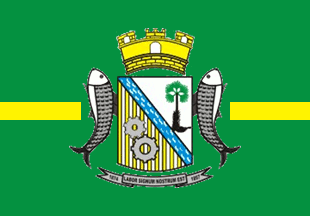 image by Dirk Schönberger, 6 June 2011
image by Dirk Schönberger, 6 June 2011Source: http://www.floriano.pi.gov.br/downloads/pafiledb.php?action=category&id=1

Last modified: 2012-04-07 by ian macdonald
Keywords: piauí | floriano |
Links: FOTW homepage |
search |
disclaimer and copyright |
write us |
mirrors
 image by Dirk Schönberger, 6 June 2011
image by Dirk Schönberger, 6 June 2011
Source:
http://www.floriano.pi.gov.br/downloads/pafiledb.php?action=category&id=1
Green-white-blue vertical tricolor, with the municipal arms in the white stripe. The flag (description) is at http://www.floriano.pi.gov.br/docs/floriano/simbolos.php.
Official website at website at http://www.floriano.pi.gov.br
Dirk Schönberger, 6 June 2011
The municipality of Floriano (57,707 inhabitants in 2010; 3,410 sq. km) is located in southwestern Piauí, 260 km of Teresina, on the border of Maranhão, here river Parnaíba, separating it from the town of Barão de Grajaú. The town is nicknamed "The Princess of South Piauí". Floriano is located on the territory where Domingos Affonso Mafrense founded in the 17th century the first cattle estates in Piauí. Mafrense, deceased in 1671, was succeeded by the Society of Jesus, which significantly developed the estates until expelled from Brazil in 1760 by the Marquis of Pombal. João Pereira Caldas, Governor of the Province of Piauí, divided the former Jesuit estates in the three Inspections of Canindé, Nazaré and Piauí. Imperial Decree No. 5,392 of 10 September 1873 established the São Pedro de Alcântara Rural Colony, made of the Guaribas, Serrinha, Matos, Algodões, Olho D'água and Fazenda Nova estates, seceding from the Nazaré Inspection. The set up of the colony was led by Francisco Parentes (1839-1876), the first agronomist in Piauí. Taught in France, Parentes was commissioned by the Brazilian Ministry of Agriculture to organize cattle estates in Piauí.The municipality of Floriano was established by Law No. 144 of 8 June 1897. The town was named for Floriano Peixoto (1839-1895), the second President of Brazil (1891-1894), aka "The Consolidator of the Republic" or "The Iron Marshal".
The flag of Floriano, drafted by Pr. Luis Paulo de Olivieira Lopes and designed by Francisco Mendes da Silva, is prescribed by Law No. 224 of 5 November 1971.
Green represents the carnuba palm, a main source of income for the municipality. The carnuba palm (Copernicia prunifera (Mill.) H. Moore), native to northeastern Brazil, is the source of the Brazil wax (see http://www.fao.org/ag/agn/jecfa-additives/specs/Monograph1/Additive-109.pdf). The central yellow stripe comes from the flag of Piauí, as a symbol of the commitment of the municipality in the life of the State and the communion of all the municipalities with the ideals of the State.
A carnuba palm is also shown in the dexter part of the shield. The
nine vertical lines in the lower part of the shield represent the nine
neighbouring municipalities. The gear wheels stand for progress. The
bend azure dividing the shield represents river Parnaíba.
The shield is supported by two minnows ("piaus", the origin of the
name of the State) symbolizing union and integration of the
municipality to the State.
The scroll is charged with the municipal motto "Labor signum nostrum
est " (Latin for "Work is our emblem") and the years of colonization
of the place ("1873") and of establishment of the "cidade" ('1897").
http://www.floriano.pi.gov.br/docs/floriano/simbolos.php
Ivan Sache, 8 March 2012